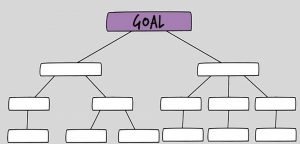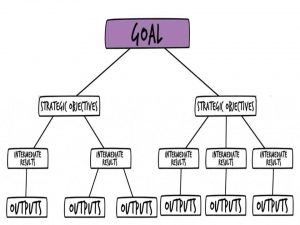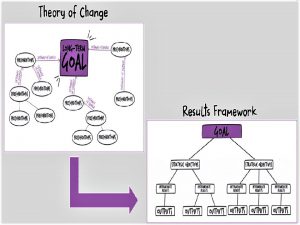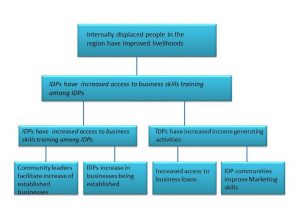To understand how to develop a Results Framework you first need to know what is a result framework. The results framework is a logic model tool that organizes the results of a project into a series of if-then relationships. The Results Framework (RF), like the Theory of Change (ToC), maps out the logic of the project strategy. Unlike the ToC, the RF only includes interventions that are the direct responsibility of the project team. For this reason, the RF presents the logic underlying a program or project in a way that is perhaps easier to understand at a glance than it is in the ToC.
The RF shows the project’s hierarchy of objectives, starting with the overarching long-term change and describing the causal (or vertical) logic of the project. At the top is the project goal.

Like other logic models, the RF varies in the number of levels and the terms used to describe those levels. The RF template used by a project will depend on the donor’s requirements or, failing that, the requirements of the organization.
In this series, we use a four-level RF model that includes a hierarchy of objectives made up of:
- Goal
- Strategic objectives
- Intermediate results
- Outputs
Including outputs in the hierarchy clarifies the project’s chosen intervention strategy in a tangible way. It can turn the RF into a very useful communication tool, showing what the project intends to achieve, and how, in a simple but not simplistic manner.

The approach to creating a results framework (RF) is to first determine the scope of the project and then transfer content from the ToC to the RF.

How to Create an RF
Step 1. Determine the scope of the project
Why is determining the scope of the project important at this stage? How to develop a Results Framework involves first recalling that the ToC provides a comprehensive picture of ALL of the preconditions and pathways of change that are needed to achieve a long-term goal. The RF, however, should focus only on the work that is the direct responsibility of the project. Defining this focus is also known as determining the project scope.
Consequently, the first step in developing an RF is to clearly identify and prioritize the criteria you will use to decide which components of the ToC will be included in the RF.
Manage discussions about scope.
You must manage the discussions that frame these decisions so that different opinions, perspectives, and requirements can be voiced in a way that is respectful and constructive. Consider the perspectives and requirements of partners, donors, and other stakeholders when making these decisions.
How do you determine the project scope?
The following are criteria for determining what is included in project intervention;
- Needs prioritization – Identify needs that received the highest level of emphasis and who stand to benefit the most.
- External considerations – Consider other organisations working in the proposed area of intervention and their strengths.
- Appropriateness – Determine if the proposed approach is acceptable to the target population and key stakeholder groups.
- Institutional capacity – What is your organisation’s strength and weaknesses and if there is need to involve implementing partners with adequate capacity levels
- Resource availability – Is funding available and what other opportunities exist to obtain additional resources?
- Financial/economic feasibility – Is the project investment justified based on the anticipated return?
- Technical feasibility and sustainability – Can the proposed work be realistically accomplished, sustained, and maintained?
- Strategic considerations
- Portfolio considerations – Is the project aligned with the larger portfolio of projects in your organization?
Step 2. Transfer content from the Theory of Change to the Result Framework
The second step in creating the RF is to take the chosen ToC elements and organize them into the project RF. Remember that this series uses a four-level RF model with a hierarchy of objectives made up of a goal, strategic objectives, intermediate results, and outputs.
Here’s how to transfer the long-term change identified in the ToC to the goal level in the RF, piece by piece.
Goal
The goal describes the longer-term, wider development to which the project contributes. Goal statements are usually aspirational, focusing on states of sustainability, livelihood, and well-being.
Write the goal as a full sentence, as if already achieved. The subject of the sentence should be the general communities of the targeted group of project participants.
An example of a goal statement is “Internally displaced people in the region have improved livelihoods.”
Strategic Objectives (SOs)
The strategic objectives level in the RF corresponds to the statements found at the domains of change level of the ToC. Transfer those ToC statements to the strategic objectives in the RF.
The strategic objectives indicate the core purpose of the project. They indicate the significant benefits that are anticipated by the end of the project. The strategic objectives address the immediate causes of the main problem.
Write them as a full sentence, as if already achieved. Make the targeted group (s) of project participants the subject of the sentence.
An example of a strategic objective statement is: “IDPs have increased access to business skills training among IDPs.”
Intermediate results (IRs)
The intermediate results (IRs) correspond to the preconditions of the ToC. They are called “intermediate” because progress at this level is a necessary step toward achieving the SOs.
The IRs express the change(s) in behaviors, systems, policies, or institutions that are expected as a result of project outputs and activities. Some examples of changes are: project participants adopting new behaviors or skills promoted by the project, expansion of project reach or coverage, new ways of organizing or managing systems, alterations to policy, or anything else that shows project outputs being used by the targeted group of project participants.
Transfer the ToC preconditions to the IRs in the RF appropriately. Write them as a full sentence, as if already achieved. The subject of the sentence should be the specific individuals or groups whose behavior is expected to change.
An example of an IR statement is ” IDPs have increased access to training facilities.”
Outputs
There may be more than one Intermediate Result for each strategic objective. The outputs (like the IRs) correspond with the preconditions of the ToC.
The fourth level of the RF is the outputs. The outputs are also known as the project deliverables. They are mostly tangible effects such as products, services, attitudes, knowledge, and skills. For example, an output statement may include “people trained with increased knowledge and skills” and “quality classes built.”
Transfer the ToC preconditions to the RF outputs appropriately. Write them each as a full sentence, as if already achieved. The subject of the sentence should be the specific individuals or groups receiving the outputs.
An example of an output statement is ” Internally displaced people have established businesses.”
Only include preconditions of the ToC that are related to your specific project; there may be more than one output for each IR.
In general, write all objectives statements clearly, using full sentences, and make sure to include information indicating: who changes? What changes? And what is the direction or nature of the change?
Vertical Logic
The “vertical logic” of the project becomes clear as you explore the linkages between the levels of the RF helps you understand how to develop a Results Framework. Starting from the top, at the long-term change, and going down the hierarchy of objectives demonstrates how a result will be achieved by achieving the result(s) below it. Going up the hierarchy of objectives demonstrates why a lower-level result is necessary to achieve the next-level result.
Example – Results Framework
We are going to have Change Life, an organization that focuses on livelihood, as a use case in developing a theory of change. Change life has a strong network of partners that includes government ministries, NGOs, and community-based organizations. The donor had asked Change Life to contribute to the development of a ToC that maps out its intervention strategy for the proposed IDP initiative. Fabiana the Program Manager at Change Life led a team in developing a Theory of Change as shown below:

“Increased access to business skills training among IDPs,” was the strategic area chosen for Change Life by the funder. That means that the preconditions falling under this strategic area were the direct responsibility of Change Life. The other two strategic areas, II and III, were the responsibility of other partner organizations.
Using the Theory of Change to Create the Results Framework
The next step for Change Life was to translate the ToC into the four-level Results Framework model. This involved selecting content in the ToC to use for each of the RF objectives statements. This is how to develop a Results Framework.
- The RF goal
The Change Life team started by taking the long-term change identified in the ToC and reformulated it into the RF goal statement. The new statement is “Internally displaced people in the region have improved livelihoods.”
- The RF strategic objective
The team chose this strategic objective (SO): “IDPs have increased access to business skills training among IDPs.” SOs express the central purpose of the project that the team will implement.
- The RF intermediate results
The Change Life team looked at the preconditions included in the ToC and determined which ones would be appropriate as intermediate results (IRs). They chose:
O “IDPs have increased access to business skills training among IDPs.”
O “IDPs have increased income-generating activities”
- The RF outputs
Finally, Change Life decided which preconditions are appropriate to use at the output level of the RF. They chose four preconditions, two relating to training facilities and two relating to income-generating activities.
The RF they created is shown below:

Conclusion
How to develop a results framework involves developing the Theory of Change then translating the Theory of Change into the four-level Results Framework model. This involves selecting content in the Theory of Change to use for each of the RF objectives statements.
The Theory of Change and Results Framework models are very good descriptions of how you will make the change when designing a project or program. They are “living documents” that require reviewing periodically to make sure that their contents continue to make sense and that they reflect the realities of the project context.

